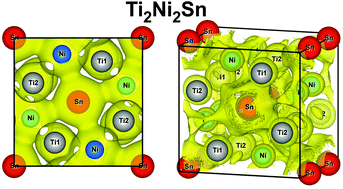Physical properties of {Ti,Zr,Hf}2Ni2Sn compounds†
Abstract
Physical properties, i.e. electrical resistivity (4.2–800 K), Seebeck coefficient (300–800 K), specific heat (2–110 K), Vickers hardness and elastic moduli (RT), have been defined for single-phase compounds with slightly nonstoichiometric compositions: Ti2.13Ni2Sn0.87, Zr2.025Ni2Sn0.975, and Hf2.055Ni2Sn0.945. From X-ray single crystal and TEM analyses, Ti2+xNi2Sn1−x, x ∼ 0.13(1), is isotypic with the U2Pt2Sn-type (space group P42/mnm, ternary ordered version of the Zr3Al2-type), also adopted by the homologous compounds with Zr and Hf. For all three polycrystalline compounds (relative densities >95%) the electrical resistivity of the samples is metallic-like with dominant scattering from static defects mainly conditioned by off-stoichiometry. Analyses of the specific heat curves Cpvs. T and Cp/T vs. T2 reveal Sommerfeld coefficients of γTi2Ni2Sn = 14.3(3) mJ mol−1 K−2, γZr2Ni2Sn = 10(1) mJ mol−1 K−2, γHf2Ni2Sn = 9.1(5) mJ mol−1 K−2 and low-temperature Debye-temperatures: θLTD = 373(7)K, 357(14)K and 318(10)K. Einstein temperatures were in the range of 130–155 K. Rather low Seebeck coefficients (<15 μV K−1), power factors (pf < 0.07 mW mK−2) and an estimated thermal conductivity of λ < 148 mW cm−1 K−1 yield thermoelectric figures of merit ZT < 0.007 at ∼800 K. Whereas for polycrystalline Zr2Ni2Sn elastic properties were determined by resonant ultrasound spectroscopy (RUS): E = 171 GPa, ν = 0.31, G = 65.5 GPa, and B = 147 GPa, the accelerated mechanical property mapping (XPM) mode was used to map the hardness and elastic moduli of T2Ni2Sn. Above 180 K, Zr2Ni2Sn reveals a quasi-linear expansion with CTE = 15.4 × 10−6 K−1. The calculated density of states is similar for all three compounds and confirms a metallic type of conductivity. The isosurface of elf shows a spherical shape for Ti/Zr/Hf atoms and indicates their ionic character, while the [Ni2Sn]n− sublattice reflects localizations around the Ni and Sn atoms with a large somewhat diffuse charge density between the closest Ni atoms.



 Please wait while we load your content...
Please wait while we load your content...